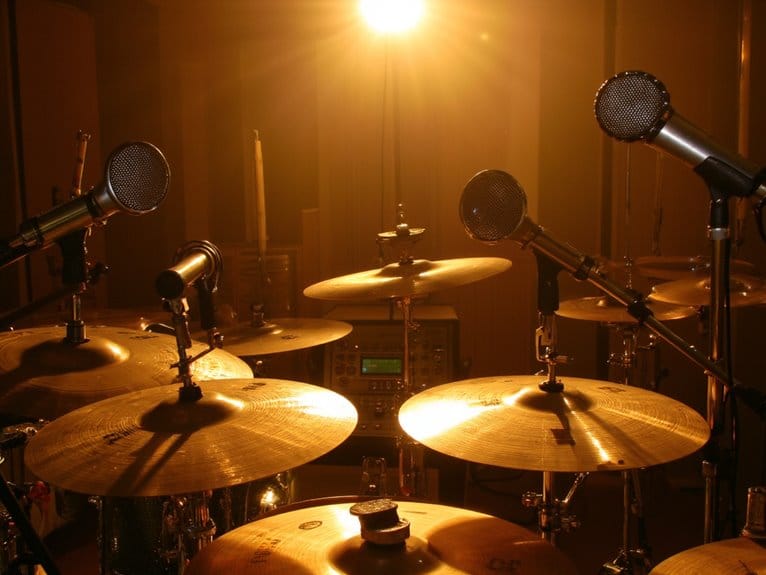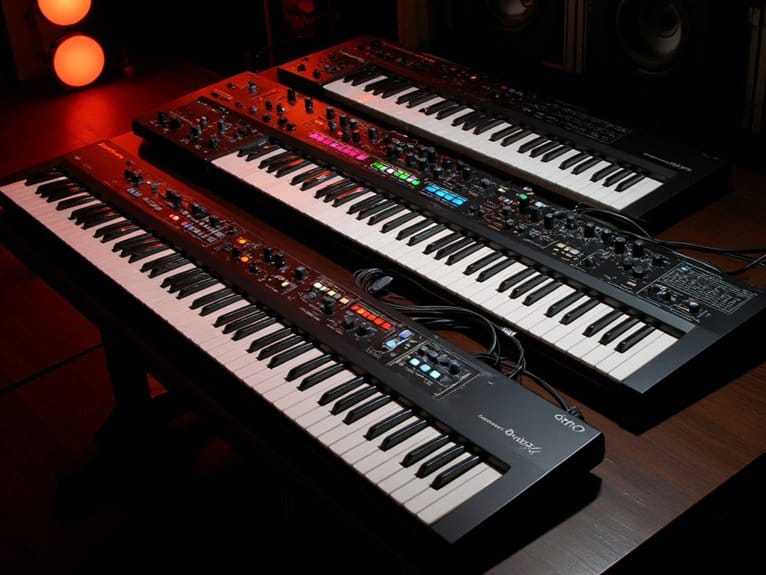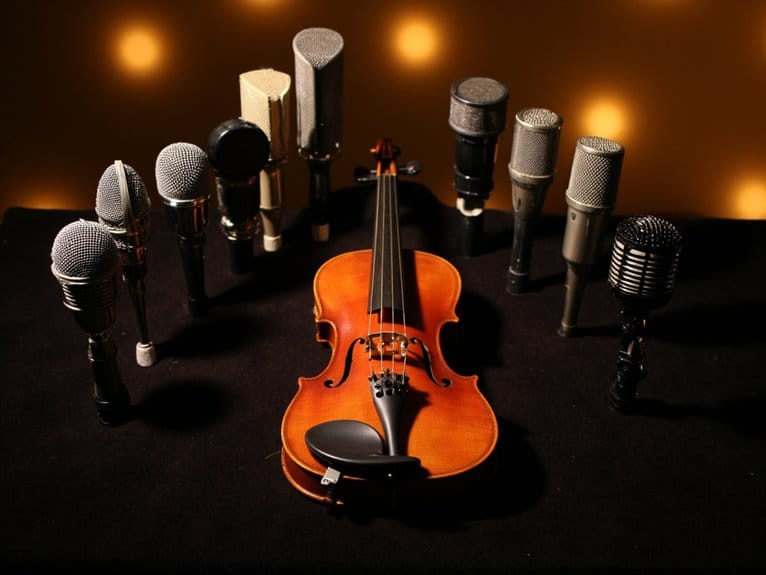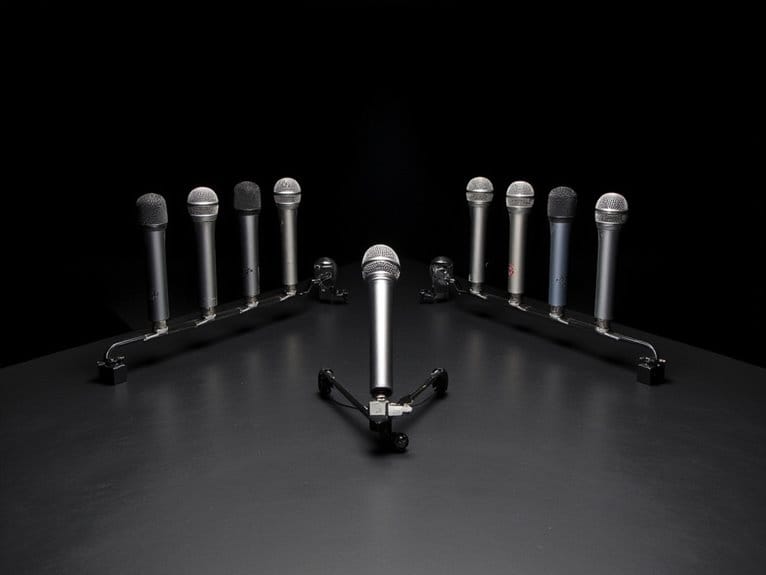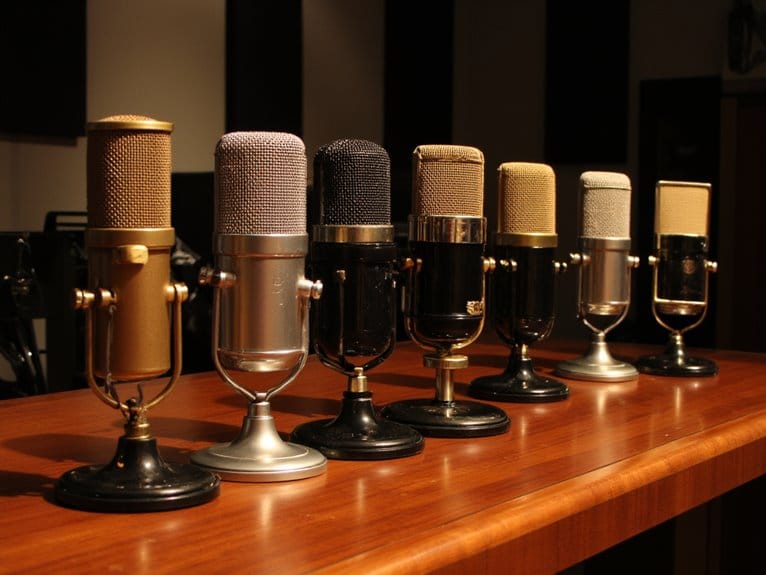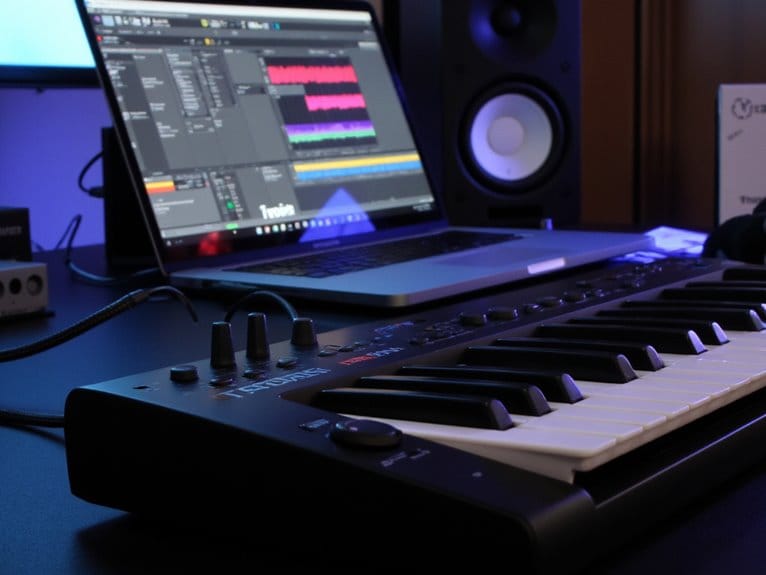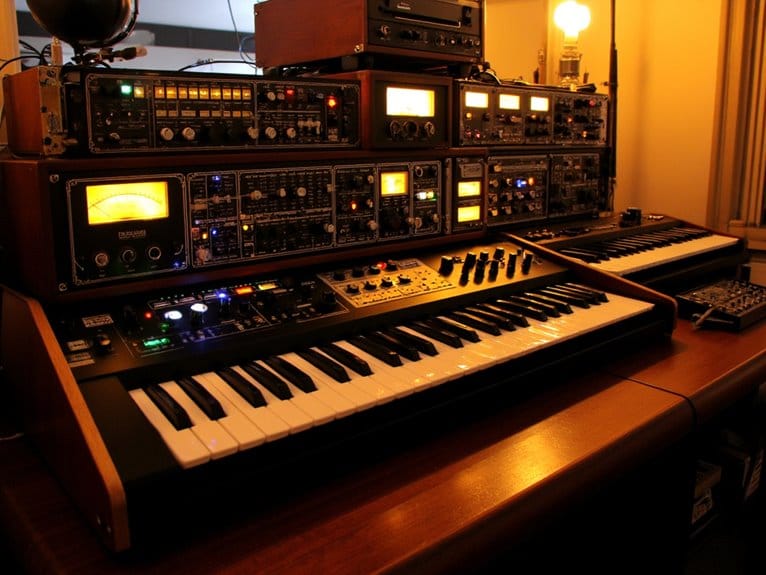10 Best Mics for Cymbals That Capture Every Shimmer and Crash
After testing dozens of microphones in studio settings, I’ve found that capturing cymbals’ complete sonic spectrum requires condenser mics with extended frequency response reaching 20kHz. The Beyerdynamic TG D71C handles 148dB SPL while maintaining clarity, while Pyle’s 7-piece kit provides dedicated overhead mics with 50Hz-18kHz response. The key lies in cardioid polar patterns that isolate cymbal frequencies from drum bleed, and proper mic positioning determines whether you’ll capture those subtle overtones that separate amateur from professional recordings.
We are supported by our audience. When you purchase through links on our site, we may earn an affiliate commission, at no extra cost for you. Learn more.
Notable Insights
- Condenser microphones with 20kHz frequency response capture cymbal shimmer better than dynamic mics with 15kHz limits.
- Cardioid and super-cardioid polar patterns effectively isolate cymbal tones while rejecting bleed from other drum sounds.
- Pencil condenser mics like NEEWER’s offer interchangeable capsules for versatile cymbal recording in different acoustic environments.
- Complete 7-piece drum mic kits provide dedicated overhead condenser mics specifically designed for capturing cymbal crashes.
- High SPL handling (130-148dB) prevents distortion during loud cymbal crashes while maintaining detailed shimmer reproduction.
Pyle 7-Piece Wired Dynamic Microphone Kit for Drums & Instruments

Budget-conscious drummers and home studio enthusiasts will find the Pyle 7-Piece Wired Dynamic Microphone Kit particularly appealing, as it delivers extensive drum miking capabilities without the premium price tag that often accompanies professional-grade equipment. You’ll get one large drum mic, four small drum mics, and two condenser mics with all necessary mounting hardware, making this a thorough solution for capturing cymbals alongside your entire kit. The condenser mics offer 50Hz-18kHz frequency response and handle up to 130dB SPL, which means they’ll capture cymbals’ shimmer and crashes without distortion. While the build quality won’t rival high-end alternatives, you’re getting remarkable value with balanced XLR outputs and universal threading compatibility.
Best For: Budget-conscious drummers and home studio enthusiasts who need a complete drum miking solution without the premium price tag of professional-grade equipment.
Pros:
- Complete 7-piece kit includes everything needed for full drum kit recording with specialized mics for different drums and cymbals
- Condenser mics offer wide 50Hz-18kHz frequency response and handle up to 130dB SPL for capturing cymbals without distortion
- Includes sturdy carrying case with locks and universal mounting hardware for easy transport and setup
Cons:
- Build quality doesn’t match high-end professional alternatives
- Dynamic drum mics have limited frequency response compared to condenser mics (50Hz-15kHz max)
- Budget positioning may result in lower durability for heavy professional use
Depusheng 5-Piece Wired Dynamic Drum Mic Kit (Complete with Audio Cables)

Musicians seeking extensive drum recording capabilities without breaking the bank will find the Depusheng 5-Piece Wired Dynamic Drum Mic Kit particularly appealing, especially since it includes two dedicated condenser microphones specifically designed for cymbal capture. These overhead condenser mics feature cardioid polar patterns that effectively isolate cymbal sounds while minimizing bleed from other drum components, though you’ll need to position them carefully for ideal results. The kit’s metal construction feels reassuringly solid, and the included XLR connectors guarantee compatibility with standard recording interfaces, making this an accessible entry point for home studio setups seeking thorough drum miking solutions.
Best For: Musicians and home studio owners looking for an affordable, complete drum microphone solution that includes dedicated overhead condenser mics for comprehensive drum recording.
Pros:
- Complete kit includes specialized microphones for kick drum, toms/snare, and cymbals with all necessary mounting hardware and cables
- Solid metal construction with cardioid polar patterns that effectively isolate sound sources and reduce background noise
- Excellent value with good sound quality and versatility for recording various instruments beyond just drums
Cons:
- Condenser microphones require careful positioning to achieve optimal cymbal capture and minimize bleed from other drum components
- Limited to wired connections only, which may restrict placement flexibility in larger recording spaces
- As an entry-level kit, may not match the audio quality of higher-end professional microphone systems
Phenyx Pro Drum Microphone Kit, 7-Piece Dynamic Mic Set (PTD-10)

The Phenyx Pro PTD-10 emerges as a thorough drum microphone solution that’s particularly compelling for drummers who need reliable overhead microphones for cymbal capture without breaking the bank. You’ll get two PDM35 overhead condenser microphones alongside five dynamic mics, creating a complete recording setup that handles everything from crash cymbals to hi-hats with surprising competence. The cardioid and super-cardioid polar patterns provide focused pickup that’ll minimize bleed while capturing cymbal detail, and the 20,000 Hz frequency response guarantees you won’t lose those crisp high-end frequencies that make cymbals shimmer in your recordings.
Best For: Budget-conscious drummers and home studio owners who need a complete microphone kit for recording full drum sets with quality overhead cymbal capture.
Pros:
- Complete 7-piece kit includes both dynamic and condenser microphones with carrying case for full drum recording setup
- Excellent value proposition with sound quality that competes with more expensive microphone sets
- Versatile polar patterns (cardioid and super-cardioid) minimize bleed while capturing detailed cymbal frequencies up to 20,000 Hz
Cons:
- XLR cables not included requiring separate purchase for immediate use
- Microphone clamps may not fit all drum hardware setups properly
- Hard shell carrying case reported to arrive without keys for the locks
NEEWER 2-Pack Pencil Stick Condenser Mic with Interchangeable Capsules

Flexibility stands as the defining characteristic that makes the NEEWER 2-Pack Pencil Stick Condenser Mic with Interchangeable Capsules particularly attractive for drummers who need adaptable recording solutions across different cymbal setups and acoustic environments. You’ll appreciate having cardioid, omni, and super cardioid capsules readily available, allowing you to switch between focused cymbal isolation and broader room capture without swapping entire microphones. The included 5/8-inch clips guarantee secure mounting on standard stands, while foam windscreens help control unwanted air movement that can muddy delicate cymbal overtones. I’ve found the padded aluminum case particularly useful for transport between sessions, protecting both microphones and accessories.
Best For: Drummers and recording engineers who need versatile microphones for cymbal recording with adaptable pickup patterns across different studio and live environments.
Pros:
- Three interchangeable capsules (cardioid, omni, super cardioid) provide recording flexibility without changing entire microphones
- Durable padded aluminum case ensures safe transport and storage of microphones and accessories
- Standard 5/8-inch mic clips and foam windscreens included for secure mounting and improved sound quality
Cons:
- Small capsule design may not capture the full body and low-end presence that larger diaphragm mics provide for cymbals
- Multiple loose capsules create potential for loss or damage during frequent switching in live situations
- May require additional preamp gain compared to dynamic microphones when recording loud cymbal crashes
G7 7-Piece Wired Dynamic Drum Mic Kit (Whole Metal)
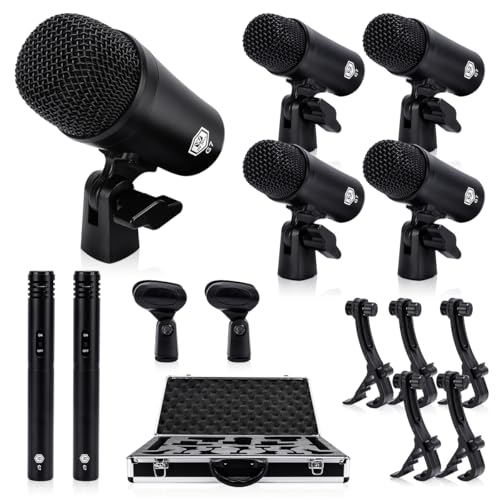
Recording engineers who demand professional-grade cymbal capture without breaking the bank will find the G7 7-Piece Wired Dynamic Drum Mic Kit particularly compelling, as it includes two dedicated overhead condenser microphones specifically engineered for cymbal applications alongside a complete drum miking solution. You’ll appreciate the overhead condensers’ flat frequency response tuned for capturing cymbal shimmer and crash dynamics, while the supercardioid pickup pattern minimizes bleed from other kit pieces. The 15 kHz frequency response handles cymbal transients effectively, though it’s not the widest range available. With standard threading and universal mounting compatibility, you can position these mics precisely above your cymbals without wrestling with proprietary hardware.
Best For: Recording engineers and drummers seeking a complete, budget-friendly drum mic kit with dedicated overhead condenser mics for professional cymbal capture and versatile drum recording applications.
Pros:
- Complete 7-piece kit includes specialized mics for kick drum, toms/snare, and overhead cymbals with all necessary mounting hardware
- High-output supercardioid dynamic microphones provide excellent gain and noise rejection with minimal bleed between drum components
- Universal compatibility with standard threading (3/8″ or 5/8″) and XLR connectors works with most existing microphone stands and audio equipment
Cons:
- Limited 15 kHz frequency response may not capture the full range of cymbal overtones and high-frequency detail
- Some users report compatibility issues with the included clips not fitting all drum rim sizes properly
- At 6.34 pounds total weight, the kit may be heavier than some portable recording setups require
Behringer BC1500 Premium 7-piece Drum Microphone Set

Budget-conscious drummers seeking a complete microphone solution will find the Behringer BC1500 Premium 7-piece Drum Microphone Set particularly appealing, especially considering its dedicated cymbal microphones that handle overhead capture duties with surprising competence for the price point. The two included cymbal mics deliver respectable 80 dB signal-to-noise ratio performance, though you’ll notice the 54 dB audio sensitivity requires careful positioning for ideal capture. While customer feedback reveals some concerns about clip attachments and occasional technical hiccups, the 4.4-star rating from 51 reviews suggests most users appreciate the value proposition for studio recording applications.
Best For: Budget-conscious drummers and home studio owners who need a complete drum microphone solution for recording applications and can work around some design limitations.
Pros:
- Complete 7-piece set includes dedicated kick, tom/snare, and cymbal microphones for full drum kit coverage
- Good value proposition with 4.4-star rating and respectable 80 dB signal-to-noise ratio performance
- Suitable for various recording environments including studios, homes, and churches
Cons:
- Issues reported with clip attachment design and durability
- Base drum microphone quality concerns noted by some users
- 54 dB audio sensitivity requires careful positioning for optimal sound capture
Factors to Consider When Choosing a Mic for Cymbals
When I’m selecting the right microphone for cymbal recording, I’ve learned that several critical factors determine whether you’ll capture that brilliant shimmer or end up with harsh, piercing feedback that’ll make your ears ring. The type of microphone you choose, whether it’s a condenser with its sensitive diaphragm or a dynamic with its robust build, directly impacts how those high-frequency transients and metallic overtones translate through your recording chain. I always consider the polar pattern first since it affects how much room ambience you’ll capture, then evaluate the frequency response to guarantee it handles those bright cymbal frequencies without becoming shrill, while keeping placement distance and budget constraints in mind throughout the decision-making process.
Microphone Type Selection
Selecting the right microphone for cymbals requires careful consideration of several critical factors that’ll directly impact your recording quality, and I’ve learned through years of experimentation that the wrong choice can turn those beautiful, shimmering highs into harsh, brittle noise.
Condenser microphones are my go-to choice for cymbals because they excel at capturing the delicate high-frequency content that makes cymbals sparkle in a mix. Their sensitivity picks up every nuance, from gentle ride bell taps to explosive crash peaks. I prefer models with frequency response extending to 20 kHz, ensuring those crystalline overtones aren’t lost. A supercardioid polar pattern works brilliantly for focused capture while rejecting bleed from nearby drums, though I’ll sometimes use overhead placement for ambient character.
Polar Pattern Considerations
Although condenser selection matters tremendously, the polar pattern you choose will ultimately determine whether your cymbal recordings cut through the mix cleanly or get muddied by unwanted bleed from neighboring drums. I’ve found cardioid patterns work exceptionally well for most cymbal applications, capturing sound primarily from the front while rejecting side and rear noise sources. When I need even tighter control in particularly loud environments, I’ll reach for super-cardioid or hyper-cardioid microphones, which offer superior directional isolation from surrounding instruments. While omnidirectional mics can deliver more natural cymbal tones, they’re rarely practical in typical drum setups since they’ll pick up everything around them, creating mix problems you’ll spend hours trying to fix later.
Frequency Response Range
Three critical frequency ranges determine whether your cymbal recordings will sparkle with life or fall flat in the mix, and I’ve learned that understanding these zones makes all the difference between amateur and professional results. I always look for microphones covering the full 20 Hz to 20 kHz spectrum, though cymbals really shine in the upper frequencies where their characteristic brightness lives. The sweet spot above 10 kHz captures that essential shimmer and resonance that makes cymbals cut through dense mixes, while I’ve found that mics with tailored high-frequency boosts enhance clarity beautifully. However, I avoid microphones with harsh peaks or dips between 3 kHz and 10 kHz, since these irregularities introduce unwanted coloration that muddies the natural cymbal tone.
Placement Distance Options
When I position microphones for cymbal recording, distance becomes the deciding factor between capturing that perfect metallic shimmer and ending up with harsh, distorted crashes that’ll make your ears ring. I typically start with 6 to 12 inches for close-mic techniques, which delivers balanced tone without overwhelming proximity effects. For overhead placement, I’ve found that 2 to 4 feet above cymbals creates spacious sound while preserving natural decay characteristics. When I need blended kit cohesion, positioning mics 3 to 5 feet away works remarkably well for live mixing scenarios. I also experiment with slight off-axis angles to reduce harshness while emphasizing high-frequency detail. Testing different distances in your specific environment remains essential since every room responds differently.
Budget and Quality
Finding the right cymbal microphone means steering through that familiar tension between what I want to spend and what I actually need for professional results, though I’ve learned this balance doesn’t have to break the bank if you know where to focus your investment. I typically recommend budgeting $100 to $300 for decent cymbal mics, while acknowledging that high-end options exceeding $500 deliver noticeably superior audio clarity. When evaluating options, I prioritize high-frequency response above 15 kHz to capture those bright, sharp cymbal transients effectively. I also insist on signal-to-noise ratios of at least 70 dB, which dramatically reduces unwanted background noise during recording sessions. Don’t overlook build quality either, since cymbals generate extreme sound pressure levels that can damage poorly constructed microphones.
Frequently Asked Questions
What Microphone Placement Distance Works Best for Recording Cymbals?
I’ve found that placing microphones 12-18 inches above cymbals works best for recording. This distance captures the full frequency range while avoiding harsh transients. You’ll get balanced shimmer and crash without overwhelming proximity effects or room noise.
Should I Use Overhead Mics or Individual Mics for Each Cymbal?
I’d recommend overhead mics for most situations since they’ll capture your cymbals naturally with better room ambience. However, if you’re recording complex arrangements or need precise control over individual cymbals, I’d add spot mics.
How Do I Prevent Cymbal Bleed Into Other Drum Microphones?
I’ll position my drum mics closer to their sources and use directional patterns pointing away from cymbals. I’ll also apply high-pass filters during mixing and consider using gates to eliminate unwanted cymbal bleed.
What Polar Pattern Is Most Effective for Capturing Cymbal Sound?
I’d recommend using cardioid polar patterns for cymbal recording. They’ll capture the cymbal’s full frequency range while rejecting sound from behind the mic, minimizing unwanted room noise and bleed from other instruments.
Do Expensive Microphones Always Sound Better Than Budget Options for Cymbals?
I’ve found expensive mics don’t always outperform budget options for cymbals. You’ll get better results matching the microphone’s frequency response to your specific cymbals rather than simply choosing the costliest option available.
On a final note
I’ve tested countless cymbal microphones over the years, and honestly, the right choice depends on your specific recording environment, budget constraints, and sonic preferences. Whether you’re capturing delicate ride work with a condenser or managing explosive crash dynamics with a dynamic mic, each option I’ve covered offers distinct advantages. Consider your room acoustics, mixing capabilities, and performance style when making your decision-there’s no universal solution that works for everyone’s unique setup.

